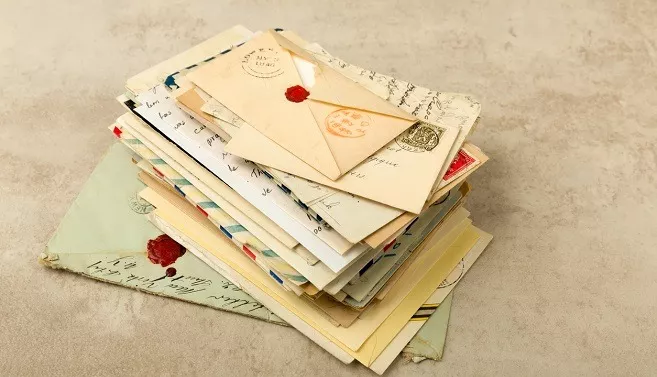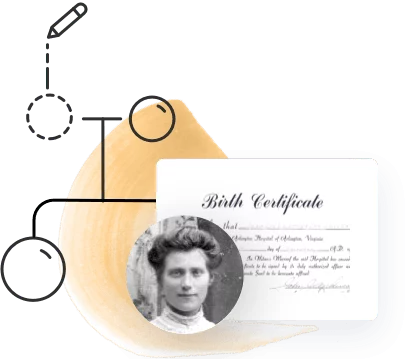
If you are fortunate enough to have a cache of old family letters, you are sitting on a gold mine. Letter writing has gone by the wayside since the invention of the telephone, e-mail, texting, Twitter, and Facebook, to name a few. Those old letters in your genealogy records collection should be preserved for future generations. Whether you have 100 letters or just one, they are important to your family history and add to your family story.
Family letters are a unique, one-of-a-kind one record collection. If they include war letters, these might have not only personal value, but historical value — especially if your ancestor wrote details about the war in their letters. Love letters are a great resource for genealogy information because they can help you learn how your ancestors met and fell in love.
This information is priceless and should be preserved.
Let’s Get Organized
First things first: get organized. Many genealogists have piles of letters, shoeboxes full of letters, or stacks of letters held together with a rubber band or ribbon. Organizing the piles will help you manage your genealogy records, and during this process, you will probably find information that you hadn’t known before.
- The simplest way to begin organizing your letters is to arrange them in chronological order. Use the date on the letter or the date on the envelope postmark — either way, be consistent.
- Do you have letters by multiple family members? Organize them first by surname, and then chronological order for each surname. This allows you to find letters by a particular person quickly and efficiently.
- If you have groups of letters for different events in your ancestors’ lives, perhaps organize them by event. For example, put all the World War II letters together, all the college letters together, etc. After you have grouped them, organize by date.
- The most important part of organizing the letters is to find a system that works for you. Then be consistent in your methods throughout the process.
Unfold and Flatten
Once you decide on an organization method, it’s time to do some preservation work. The Society of American Archivist Glossary of Terms defines preservation as “taking action to prevent deterioration or loss.”
As an archivist, the number one question about old family letters genealogists ask me is: ”Do I leave the letter in the envelope or take it out?” My answer is always: Take the letters out of the envelopes.
Leaving letters folded and in their envelopes will do more damage as time goes by, because each time someone takes them out and unfolds and refolds them, they weaken the folds and increase the risk of tears or rips. You don’t want your letters to be damaged. Here are some steps you can take at home to ensure that your old family letters stay in good condition.
- Take each letter out of its envelope and unfold it so it is flat. CAUTION: Keep each letter with its envelope and be careful not to mix up letters and envelopes. I suggest that as you remove and flatten each letter, use a plastic paper clip to hold the letter to its envelope. DO NOT use metal paper clips or metal of any kind (such as staples) on your documents! Metal clips and staples will damage your documents by rusting and adhering to your documents, causing stains and tears when you try to pry the clips from the paper.
- If your letters have been folded up and in their envelopes for a long time, they may not lay flat automatically. In this case, you will need to gently help them flatten. Lay the letter on a clean, dry surface out of the sunlight where they can be left untouched for a period of time. Be sure to lay the envelope with the letter so they don’t get separated, even if the envelope doesn’t need flattening.
Encapsulate
Now that you have flattened your letters, you are ready to encapsulate them. The term encapsulate means “to enclose something or completely cover something.” The purpose of encapsulating your letters and envelopes is to completely protect them from damage while being handled. Ideally, you shouldn’t be handling your letters much, but encapsulating them will also help keep dust and dirt from getting on them.
- Purchase archival document sleeves that are acid-free, lignin-free, and have passed the P.A.T. (Photographic Activity Test). The material used in these sleeves can be mylar, polyester, or polypropylene. The sleeves come in all sizes to accommodate different letter stationary. Be sure to get the size that fits your letters properly and leaves about one-quarter inch of space all around. You do not want to stuff letters in the sleeves or have too much room in the sleeves allowing the letters to slide around. Do not skimp on this step; failing to use proper sleeves can cause damage to your documents.
- Make sure to place the envelope with the letter in the sleeve. If your envelope still has the flap intact, make sure it is folded down on itself so it is not touching the letter: The glue strip still on the envelope flap may contain chemicals that could damage your letter upon contact.
- When you have placed your letter and envelope together in the sleeve, you will see that immediately the sleeve will close around the document via static electricity. This keeps the sleeve closed to protect your letters and prevents them from falling out.
Once the letters are encapsulated, place them in archival file folders and then into filing cabinets, or store them in three-ring binders.



